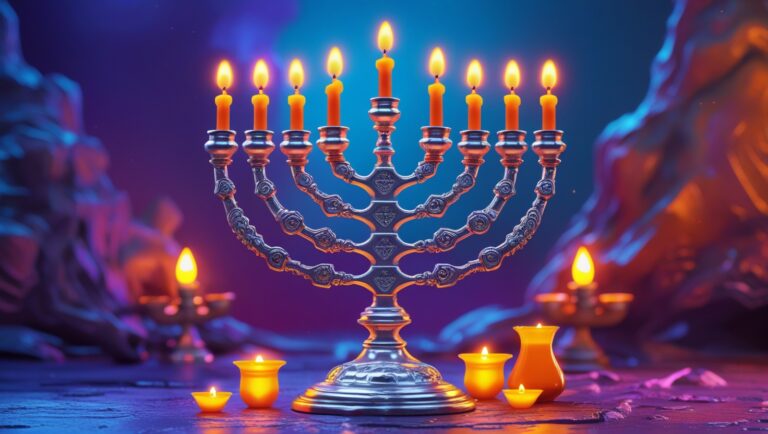The introduction to Etz Chaim (The Tree of Life) by R’ Chaim Vital is one of the most powerful Mussar lessons I found
In the beginning of the introduction, R’ Chaim Vital expresses his sense of confusion and frustration as he reflects on the state of the world and the delay of redemption. Using sorrowful language, he laments how a full day and a half of Hashem’s time (1500 years of our time) has passed since the destruction of the Temple, and still, we are not redeemed.
He draws on the verse from Jeremiah (8:20), “The harvest season has passed, the summer has ended, and we have not been redeemed,” highlighting the anguish that no solution has arisen for the deep affliction of the Jewish people. Despite the passing centuries, we continue to live in exile without any sign of the long-awaited redemption.
Intriguingly, R’ Chaim Vital poignantly points out that the time has already turned, in other words, the Day of God, which is like one thousand years, has moved into the second day, yet the Mashiach has not arrived.
Also noteworthy is his assertion that all the signs that were supposed to pass before that, have already passed even almost 500 years ago.
The mission of R’ Chaim Vital and the Etz Chaim
R’ Chaim Vital’s reflection is also steeped in a sense of urgency and responsibility. Citing the Talmud (Jerusalem Talmud Yoma 1:1), which teaches that “each generation that does not witness the rebuilding of the Temple must regard itself as if the Temple was destroyed in its own day,” he feels personally compelled to investigate the reasons behind this extended exile. In doing so, he takes it upon himself to explore why the messianic redemption has not occurred in his time, searching for answers to the delay in the reemption.
He then continues by contemplating the current state of Torah study and its implications for the delay in redemption. We find there a passage from Tikunei haZohar (77b) that states, “Even those who toil in the study of Torah enact this kindness only for their own sake.” This insight reveals a deep concern for the state of Torah study in his time, where the sacred learning of Torah, once a path to spiritual elevation, has become tainted by selfish motives.
Instead of studying Torah purely for the sake of connecting with Hashem, many fake rabbis have turned it into a means to gain personal benefits, whether financial, social, or for the sake of fame and status. This shift from sincere devotion to ego-driven pursuits is troubling to the holy author, as it weakens the true power of Torah and its ability to bring about redemption.
(indeed the Arizal writes elsewhere that any Talmud Torah that doesn’t have Teshuva with it causes the Sitra Achra to be fed).
Sadly, Rabbi Chaim Vital then goes on to compare these misguided scholars to the builders of the Tower of Babel. Just as the people of Babel sought to build a tower that would reach the heavens in an attempt to make a name for themselves (Bereshit 11:4), so too do these so-called “masters of Torah” engage in their learning and teaching to gain recognition and prestige. They study not out of genuine love for Torah or a desire to connect with God, but to bolster their own reputations, much like those who built the tower to glorify themselves.
Drawing from the Zohar (1:25a-b), the introduction continues to cite five types of ‘mixed multitude,’ (Erev Rav) and among them are the “mighty men of old,” the ones who seek renown and power through their actions. He references the verse from Bereshit (6:5) about the “mighty men of old, the men of renown,” and likens them to those who build synagogues and Torah scrolls adorned with crowns not for pure, holy reasons, but to serve their own personal agendas.
This behavior is not only a betrayal of the Torah’s sacred purpose, but it also perpetuates the exile and delays the coming of the Mashiach. We can then have a more comprehensive idea of why the Redemption has not yet arrived.
The study not for the sake of Heaven
In his reflections, R’ Chaim Vital also references a teaching from the Talmud Bavli Berakhot 17b, which harshly critiques those who study Torah with ulterior motives. The Talmud states that those who study with impure intentions would have been better off never being born, as their actions distort the true nature of Torah. This sharp rebuke shows the gravity of the situation: the delay in redemption is not just a consequence of external forces, but also of internal corruption within the Jewish community. The improper study of Torah, driven by selfish motives rather than a pure desire to serve Hashem, contributes to the ongoing exile and the postponement of the redemption.
Through these reflections, we find a piercing and urgent message: The delay of the redemption is not only a result of external circumstances but also of our own shortcomings in Torah study and spiritual integrity. Only when we return to the pure, selfless study of Torah, without the distractions of personal gain or recognition, can we hope to bring the redemption closer and merit the arrival of the Mashiach.
R’ Chaim Vital now shifts his focus to the issue of the purity of intention in Torah study, addressing the people who may protest against the accusation of selfishness in their learning. He acknowledges that many of them would likely be astonished by such a charge and would humbly claim that their study of Torah is driven by pure motives.
However, we find the quote by Rabbi Meir from the Mishnah in Pirkei Avot (6:1), which offers a clear test of true purity in Torah study. Rabbi Meir teaches that those who study Torah with pure intent merits many blessings, and the deepest secrets of the Torah will be revealed to them. This Torah, studied with sincerity and devotion, flows effortlessly from their mouths, like roaring rivers and wellsprings that rise spontaneously. The image of Torah as flowing water conveys the idea that when one’s study is genuine, the Torah’s true essence will emerge naturally, without struggle.
R’ Chaim Vital then contrasts this image with those whose Torah study yields only “droplets of Torah-water extracted from stone,” a metaphor for how the Torah studied with improper intent is barren and dry, like an effort that fails to penetrate deeply. This image calls us to reflect on our own Torah study and to recognize the gaps between our aspirations and our actual practice. The act of pulling water from stone is futile, just as studying Torah without proper intention is ultimately unfruitful. This stark comparison encourages a deep self-examination in all of us, and prompts the reader to be moved to tears by the realization of how far we may fall short of the ideal.
The revelations from above
From here, R’ Chaim Vital delves into the profound structure of the Torah as it exists in all four spiritual Worlds, which are Atzilut (Emanation), Beriyah (Creation), Yetzirah (Formation), and Assiyah (Action). He emphasizes that the Torah is not a static entity but exists in multiple dimensions, each reflecting a different aspect of God’s revelation. In the World of Emanation, Torah is the most exalted, as it is divested of any external, material coverings.
In this highest realm, the Torah is purely good (with some evil detached), its meaning detached from the literal narrative and focused on its inner essence (sod). The verse from Song of Songs (5:3) serves as an allusion to this process, where the “garments” of the Torah are removed, revealing the true spiritual core. This highest level of Torah is known as Kabbalah, the secret wisdom of Creation, and it is through this wisdom that Hashem created the worlds. (and this is what we will also be studying in Olam HaBah).
R’ Chaim continues to teach that in this exalted World of Emanation, the Torah is not concerned with the surface stories of the Tanakh, such as the creation of Adam or the tale of Balaam’s donkey. Instead, it deals with the deepest mysteries, the inner workings of creation, the divine holy wisdom that existed before the physical world was brought into being.
This Torah, which Hashem delighted in for two thousand years before the act of creation, is what the Kabbalists refer to as the Wisdom of the Divine Chariot (Merkavah), and it is through this wisdom that the divine will is revealed.
The Torah in the World of Emanation is pure, free from the taint of any evil, as it represents the divine presence unencumbered by lower spiritual frequencies (like the lower 3 worlds). The verse from Isaiah (42:8) says: “I shall not bestow My Glory upon another,” to show that the Torah in this realm is pure light vis-a-vis us. It is what it is.
However, as the Torah (which is Hashem’s will) descends through the worlds, it takes on different forms and faces more complexities. In the World of Formation (Yetzirah), for instance, the Torah is manifested through the teachings of the Mishnah, which represents a duality of good and evil, pure and impure, permitted and forbidden. Here, the Torah is compared to a handmaiden, serving the higher truths in a less direct manner. The Mishnah, with its laws and rulings, presents a more structured, but also more limited, understanding of Torah. It is in the World of Formation that we find the Torah in its more practical, rule-bound aspect, where it addresses the external realities of life.
R’ Chaim Vital goes further by illustrating the dual nature of the Torah as it exists in these lower realms. He explains that just as the Mishnah has both permissible and forbidden aspects, it also has an inner dimension, the soul of the Torah, which is hidden from the untrained eye. This deeper probing can only be accessed when one awakens to the true meaning of the Torah, just as dreams are only understood upon awakening.
He draws from the Talmud Bavli Sanhedrin 24a to explain that without the illumination of the Zohar (the Book of Splendor) the Babylonian Talmud remains in darkness. The Zohar is the key that unlocks the secrets of the Torah, shedding light on its hidden meanings.
Rabbi Chaim Vital uses the metaphor of wheat and chaff to describe the Torah’s secrets. Just as the wheat is hidden within the outer layers of the stalk, so too are the deeper truths of the Torah veiled beneath the surface. The Torah, in all its layers, needs to be carefully harvested, separating the wheat from the chaff. This process of peeling away the outer shells to reveal the kernel of truth is a metaphor for the study of Kabbalah.
The sorry state of Torah even in his days
Finally, R’ Chaim makes a poignant statement about the current state of Torah study.
He laments the fact that many scholars study the Torah only in its most surface-level forms, focused on the practical laws without delving into its deeper, spiritual teachings. He warns against those who consume only the “stalks” of the Torah, leaving the true, inner “wheat” behind. These are the scholars who engage in Torah study with a limited perspective, focused on the technicalities of permissible and forbidden, but who fail to access the light that lie beneath.
Through this, R’ Chaim is urging us to elevate our study of Torah, to look beyond the surface and seek out its deeper, spiritual dimensions. Only when we engage with the Torah in its full depth, through the study of Kabbalah and its secrets, can we fully experience its transformative power and bring about the redemption.
However, one must not be mistaken in thinking that the study of the Mishnah and the Talmud, in their apparent simplicity, is inconsequential.
On the contrary, the study of these texts in their most literal form serves as a preparation, a means to cultivate the mind and spirit for deeper pursuits. Yet, this is merely the surface, these are the ‘garments’ of the Torah, as the Zohar calls them, the outer covering that encapsulates the deeper, hidden light of the Torah’s soul. The study of Mishnah in its barest form does not illuminate the mind by itself. It is through its connection to the Wisdom of Kabbalah that the true light, the inner flame, is kindled.
To explain better: a building is only as strong as its foundations. The foundations are the revealed parts, while the other parts is the concealed wisdom of Kabbalah.
The introduction continues: To engage in the Mishnah with the intent of revealing its inner meaning is to enter the orchard of the soul, but one must not rush in before one’s intellect is sufficiently attuned. As the sages have taught, one must not enter the ‘Pardes’ (the Orchard) without first having established oneself in the fundamental principles of Torah, namely, the study of Scripture, Mishnah, and Talmud. These are the roots that stabilize the soul, grounding it before it seeks to soar into the hidden realms of divine wisdom. Just as the body cannot live without the soul, so too can the mind not live fully without the inner light of Kabbalah.
And yet, one should not be disheartened if the path to mastering the intricacies of the Talmud seems distant or arduous. Some are naturally inclined toward the complexities of the Talmud, while others may struggle with its dialectical method. The Talmud itself speaks of this distinction, stating that a student who finds no benefit in such study after years of effort should not expect a sudden breakthrough.
Those who have the mental capacity, the author writes, should study 2 (or more) hours of Talmud and Halacha, while those who can’t should strive to study at least 1 hour and the rest devote it to Kabbalah. Either way, one should not think that he should master the entire revealed parts before moving on to study the Sod.
Therefore, it is wise for such [latter] individuals to turn their hearts toward the more accessible Wisdom of Truth, the Kabbalah, where the light shines more directly and with greater ease. The soul that is unsteady in its grasp of legal arguments might find solace in the deeper teachings, which transcend the limitations of the earthly mind.
The merit of Pilpul
But for those who are able to immerse themselves in the dialectical intricacies of Halachah, there is great merit. To engage in the study of the law, to labor in the interpretation of its words, is to break through the outer ‘shells’ (klipot) of understanding and reveal the kernel of truth that lies within (i.e. It is certainly a necessary step to probing the wisdom of Kabbalah).
The Mishnah, in its duality, embodying both purity and impurity, permission and prohibition, acts as a key to unlocking the secrets of the Torah. This duality mirrors the struggle between the inner soul and the outer world, the clash between holiness and the materiality of existence. By engaging with the Mishnah in this way, one is able to remove the negative ‘shells’ of the evil inclination and begin to reveal the Torah of the Tree of Life, the Wisdom that leads to eternal connection with the Divine.
And so, the Torah, in its manifold forms, directs us toward a higher purpose, to a more refined understanding of Hashem. Whether one studies the laws of the Talmud or the Secrets of the Kabbalah, the ultimate aim is the same: to encounter the Divine presence, to open the heart to the wisdom that flows from the Tree of Life.
Thus, one must not neglect the outer forms of Torah but rather use them as stepping stones toward the ultimate revelation of the Divine Light. Only then, when the soul has been prepared through rigorous study and spiritual work, can one truly adorn the ‘Matron,’ the Shekhinah, with the deep Wisdom that resides in the secret teachings of the Torah.
For, as the Zohar affirms, the outer garments of Torah are important, but they are not the goal. The goal is to connect to the soul of the Torah of Life, that transcends all material boundaries and brings us into direct communion with the Creator. This, the true Torah, is the highest form of illumination and is what must be sought by the true seeker of wisdom.
Ad kan (until here) the first part of the Introduction to Etz Chaim by the Holy Rabbi Chaim Vital.
May his memory be for a blessing.







